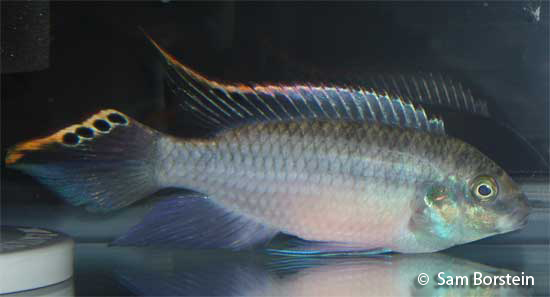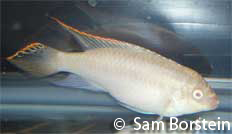Pelvicachromis pulcher
(Boulenger, 1901)
Kribensis, KribsSynonyms: Pelvicachromis kribensis

Above: A male Krib. Photo by Sam Borstein.
Etymology:
Genus- Pelvio=belly (Latin), chroma= color (Latin). Referring to the colorful belly of females.
Species- pulcher= Beautiful (Latin).
Intro:
Kribs were some of the first West African cichlids ever to come into the hobby. This fish is well known by cichlid keepers, as well as other freshwater fish keepers because this fish is beautiful with its long fins and is peaceful. This fish can be kept with Danios, Tetras, Plecos, etc.
There are a few color variants of this fish, the most popular in the hobby are the red and yellow variants. There is also a line bred albino variant.

Above: An albino Kribensis. Photo by Sam Borstein
Distribution:
Kribs is found in coastal regions of Nigeria and in West Cameroon. There are many different location varaints of these fish and some wild specimens do trickle into the hobby.
Size, Maturity, and Sexual Dimorphism:
Size: Males- 4 inches, Females- 2.5 inches
Maturity: 2 inches
Sexual Dimorphism: Males are larger and have much longer fins than the females. Females have a great amount of red in their belly. This color really comes out before and after the fish spawn.
Care:
Kribs are easy to care for. This fish does well in both hard and soft water, and will do fine in a large range of p.H. levels. This fish is not really messy, so water changes can be done every other week, but for breeding them, I recommend 50% every week. This fish is not aggressive, except when spawning. Be sure to put rocks, and caves in the tanks, because this fish can be shy.
Kribs can be kept in almost any tank larger than 5 gallons. I had a breeding pair, and multiple generations of fry, in a 10. This fish also can go into a community tank and can be kept with nearly anything. I have seen Kribs with Danios, Cory Cats, Plecos, barbs, etc., and even other cichlids including Lamprologus and Angel Fish.
Diet:
Kribs tend to feed on algae and higher plants in the wild. Stomach analysis of this fish showed a fair amount of sand in the stomach, which suggests it picks through the substrate(Lamboj, 2004). I fed mine spectrum, and a veggie flake. I also fed baby brine shrimp every day, and the fish love it. This also triggers them to spawn.
Breeding:
Another reason Kribs are popular is that they are easy to breed. Spawning becomes obvious when the females stomach turns a much more intense red than usual. Also, the females will really fatten up. Females display to males and it is quite a sight to see. The female will curve her body into an S shape and display to the male in front of a cave. This type of breeding display is very similar to the South American pike cichlids.The fish will lay 25-100 eggs in caves with small entry ways. The parents care for the larvae well, after they hatch 3 days post spawn. A week post spawn, you will see both parents guiding relatively large fry through the tank. The fry are easy to raise on baby brine shrimp and crushed flake.
Conclusion:
If you are just getting into cichlids, especially the West African, this is a good starting fish. The fish is not only beautiful, but peaceful and easy to breed. This fish is also widely available. You can almost always find this fish at pet shops, and it is always in fish clubs. Give this fish a try.
References:
- Lamboj, A. (2004). The Cichlid Fishes of Western Africa. Bergit Schmettkamp Verlag, Bornheim, Germany, 255 pp.
